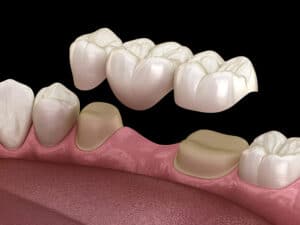Which is Right for You: Crowns or Bridges?
Restorative dentistry and cosmetic dentistry have made leaps and bounds over the last few decades, with new techniques and better patient outcomes increasingly common. Even common techniques in these fields of dentistry keep improving, among them crowns and bridges. While they are often mentioned together, dental crowns and dental bridges are different procedures and prostheses which do different things. So which is right for you: crowns or bridges? Let’s take a look at what they are and how they work in order to answer this question.
Let’s start with dental crowns, as they’re likely a more common procedure and a bit simpler to explain. A dental crown is just what the name implies: a cap or covering placed on an existing tooth and held in place with a strong dental adhesive. Dental crowns are put in place as a means of repairing a damaged tooth. The damage repaired by a crown may come in many forms but some of the more common reasons for a dental crown include:
- A fractured, chipped or cracked tooth
- Extensive tooth decay, resulting in damage beyond what a filling might repair
- Severely stained, yellowed, or otherwise discolored teeth
- As a means of protecting teeth with large fillings
- In some cases misaligned, misspaced, and misshapen teeth
Crowns are generally fairly easy to install, with minimal discomfort to the patient. With a little care, they last for years if not a lifetime, and function just like natural teeth do, allowing the patient to take part in a full range of normal activities.
Dental bridges are a type of dental prosthesis designed to replace a missing tooth or teeth. They work as the name implies: the natural teeth on either side of the missing space are used as anchors and a prosthetic tooth or teeth are connected between them, filling the empty space and replacing the missing tooth. The base and anchors of the dental bridge are made of metal, but the prosthetic tooth itself is made of porcelain which looks and feels like a natural tooth. In fact, once installed a dental bridge functions just like a natural tooth and allows a patient to do anything their natural teeth could do. Again, dental bridges are used to replace lost or missing teeth and dental crowns are generally fairly easy to install with minimal discomfort to the patient.
So which is right for you? As you can see, dental crowns and dental bridges do two different jobs. If you have a damaged tooth that needs to be preserved and protected, a dental crown is likely the right choice. If you have a missing or lost tooth, a crown might be the ideal way to replace it. Both serve a role in helping improve your smile, and both are good options for many people.
Once in place, dental bridges and dental crowns both need the same care that natural teeth do: regular brushing and flossing, a healthy diet, and twice a year trips to the dentist for exams and cleanings. Both can last for years if not a lifetime with proper care.
